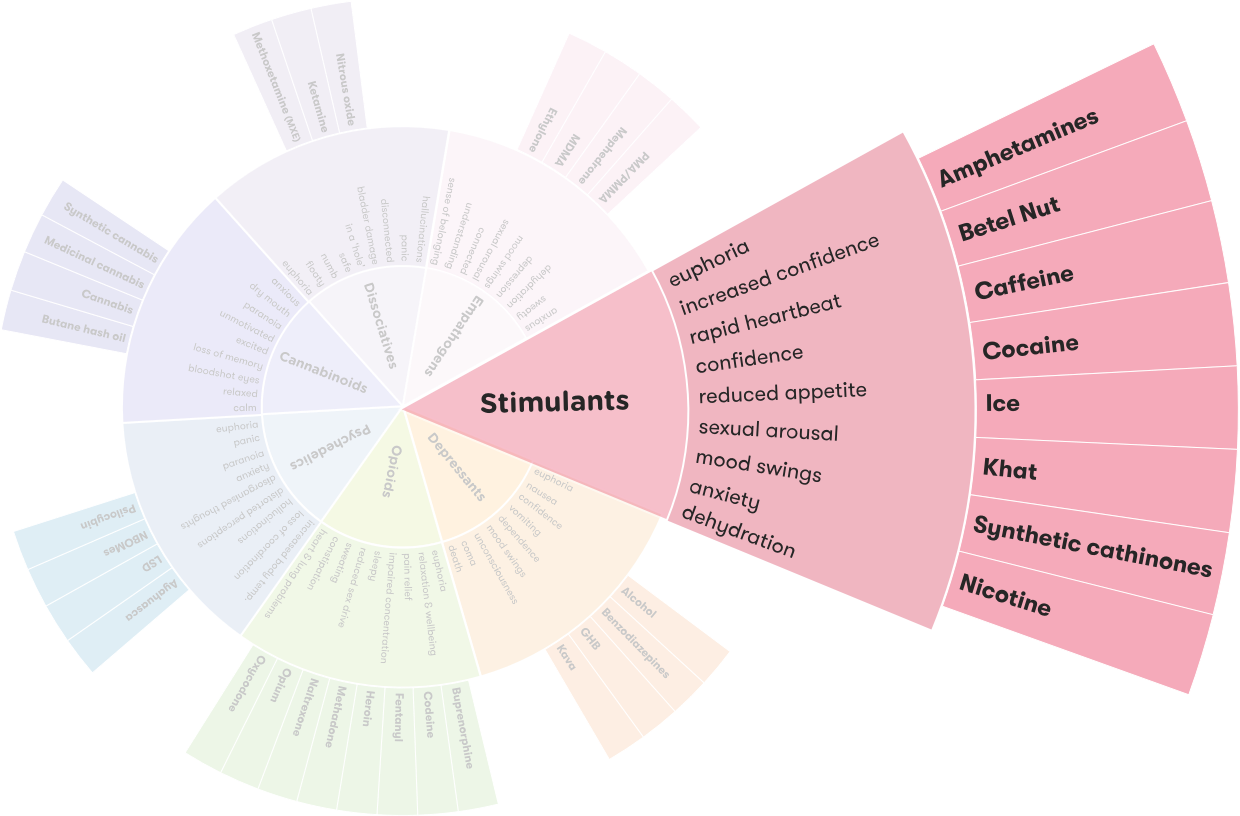Mark Halsey is a licensed therapist, founder, and chief editor of Clean Break Recovery. With over a decade of addiction treatment experience, Mark deeply understands...Read more
Stimulant drugs are substances that can cause a person to become more alert and attentive. They can be found in prescription medications, over-the-counter supplements, and even certain foods. But what exactly are these drugs, and how do they work? In this article, we’ll discuss the different types of stimulant drugs, their effects, and the potential risks associated with using them. We’ll also explore the possible benefits of stimulant drugs, and offer tips for using them safely. So if you’re curious about the world of stimulant drugs, keep reading.
Stimulant drugs are substances that temporarily increase alertness and physical activity. These substances range from caffeine and nicotine to cocaine and amphetamines. Stimulants can be taken orally, inhaled, or injected, and can have short-term effects such as increased energy, alertness, and improved concentration. Long-term use of stimulants can lead to addiction and other serious health problems.

What Are Stimulant Drugs?
Stimulant drugs are drugs that increase alertness, create energy, increase concentration, and give a feeling of euphoria. These drugs are often used to treat mental illnesses, attention deficit disorder, and narcolepsy. Stimulant drugs act on the brain, increasing the levels of dopamine and norepinephrine in the brain and stimulating the central nervous system. Stimulant drugs can also be used recreationally and are highly addictive.
Types of Stimulant Drugs
There are two main types of stimulants drugs: amphetamines and methylphenidate. Amphetamines are stimulants that act on the central nervous system and increase alertness, reduce fatigue, and create a sense of euphoria. Amphetamines include drugs like Adderall, Vyvanse, and Dexedrine. Methylphenidate is a stimulant that is used to treat attention deficit disorder and narcolepsy. Common forms of methylphenidate include Ritalin, Concerta, and Daytrana.
Side Effects of Stimulant Drugs
Stimulant drugs can have a variety of side effects. Common side effects include insomnia, increased heart rate, increased blood pressure, increased body temperature, increased sweating, and increased appetite. Stimulant drugs can also cause headaches, nervousness, irritability, and anxiety. In addition, long-term use of stimulant drugs can lead to addiction and physical dependence.
Uses of Stimulant Drugs
Stimulant drugs are often used to treat mental illnesses, attention deficit disorder, and narcolepsy. Stimulant drugs can also be used to increase alertness and concentration, and to give a feeling of euphoria. Stimulant drugs are also often used recreationally and are highly addictive.
Risks of Stimulant Drugs
Stimulant drugs are a class of drugs that can have serious side effects and can be addictive. Stimulant drugs can increase alertness and concentration, but they can also cause insomnia, headaches, anxiety, and irritability. Long-term use of stimulant drugs can lead to physical dependence and addiction. It is important to use stimulant drugs only as prescribed by a doctor and to be aware of the risks associated with them.
Related Faq
What Are Stimulant Drugs?
Answer: Stimulant drugs are a class of psychoactive drugs that increase alertness, attention and energy levels, and elevate mood. Common stimulants include caffeine, cocaine, amphetamines and methylphenidate (Ritalin). Stimulants work by increasing levels of the neurotransmitters dopamine and norepinephrine in the brain, which can affect mood and thinking.
What Are the Effects of Stimulant Drugs?
Answer: Stimulant drugs can produce a range of effects, including increased alertness, energy and focus, improved mood and decreased appetite. They can also increase heart rate and blood pressure, and can cause anxiety, paranoia and restlessness. Over time, stimulants can lead to physical and psychological dependence, as well as increased tolerance, which means more of the drug is needed to achieve the same effects.
How Are Stimulant Drugs Used?
Answer: Stimulant drugs are used to treat a variety of conditions, including attention-deficit/hyperactivity disorder (ADHD), narcolepsy and obesity. They are also used to boost energy and alertness, and to enhance performance in sports and other activities. Stimulant drugs are typically taken orally, but can also be snorted, injected or smoked.
Are Stimulant Drugs Dangerous?
Answer: Stimulant drugs can be dangerous, especially when taken in high doses or without a prescription. Overdosing on stimulants can lead to a dangerous, potentially life-threatening condition known as “stimulant psychosis,” which can cause violent behavior, paranoia and hallucinations. Stimulant drugs can also be addictive, and can cause physical and psychological dependence.
What Are the Side Effects of Stimulant Drugs?
Answer: Common side effects of stimulant drugs include increased heart rate and blood pressure, insomnia, loss of appetite, anxiety and irritability. Stimulants can also cause headaches, dizziness, nausea, vomiting and sweating. Over time, long-term use of stimulant drugs can lead to mental and physical health problems, such as depression, weight loss and heart problems.
What Are the Alternatives to Stimulant Drugs?
Answer: Stimulant drugs are not the only treatment for conditions such as ADHD, narcolepsy and obesity. Non-stimulant drugs, such as atomoxetine (Strattera) and clonidine (Kapvay), can be used to treat these conditions. Behavioral therapy, lifestyle changes and natural remedies such as herbs and supplements can also be used to treat symptoms of these conditions.
Pharmaceutical Stimulants Use and Misuse
In conclusion, stimulant drugs are powerful medications capable of treating a variety of mental and physical illnesses. While they can provide great benefit, they are also highly addictive and potentially dangerous when abused. It is important to discuss all the risks and benefits with a medical professional before taking any stimulant drug. With proper precautions and medical supervision, stimulant drugs can be a helpful tool in managing mental health conditions and other illnesses.
Mark Halsey is a licensed therapist, founder, and chief editor of Clean Break Recovery. With over a decade of addiction treatment experience, Mark deeply understands the complex needs of those struggling with addiction and utilizes a comprehensive and holistic approach to address them. He is well-versed in traditional and innovative therapies, including cognitive-behavioral therapy, motivational interviewing, and mindfulness-based interventions.
More Posts